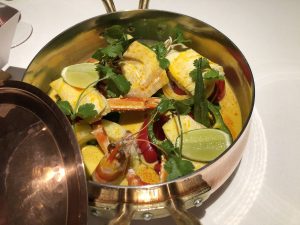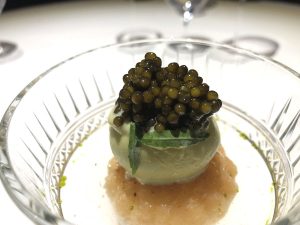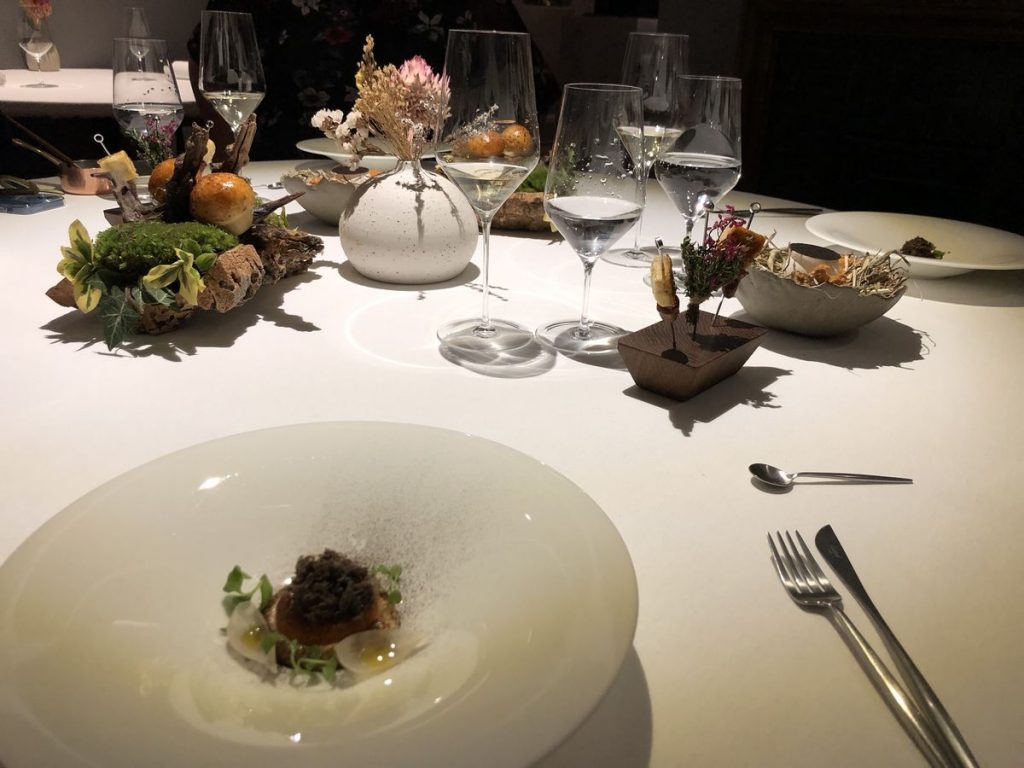
Da Terra
Tacos are definitely the fine dining cliche from the last 2 or 3 years. It’s the strangest thing, but I’d swear that three quarters of the tasting menus I’ve eaten lately have included some form of taco. There’s no real point I’m heading for here, I can’t really mock the trend or fall in love with it. Maybe I’m just showing off? After 10 years of food blogging, I can spot a trend!
Anyway, the taco at Da Terra was a classic blue corn shell, albeit smaller than my little finger, filled with beef tartare and smoky with coal oil. It was very good, but nowhere near the best dish we enjoyed. We went with the longer menu, ten courses and snacks, and enjoyed a colourful array of visually stunning creations over a leisurely five hours.

Moqueca
Da Terra is one of those restaurants-in-unexpected-places; you stroll briskly from the tube station along a main road past dubious bars and grubby corner shops, then cross over to the one impressive building amongst a load of concrete jungle. Inside you’ve got a lovely intimate dining room with an open kitchen, dark and cosy corners but (photographer’s joy!) really good task lighting right over the tables. Service is great, chef Rafael Cagali introduces a couple of the dishes himself, and we found a couple of bottles of really good wine.
Where Da Terra shone for me was in the beauty of the presentation. Every dish had several elements and the sense of being a little vignette or stage set. If you’re of the “don’t care, get in my mouth” school of dining you might be eye-rolling about now, but I ate up every charming set piece with my eyes way before actually eating it. And as you’d expect at the two-star level, the food itself was all perfect. Cagali’s cooking is full of robust flavours but all done with refinement. Like a Lamborghini or something. I’m not good on car analogies. Something powerful but also elegant. Is that right?

Caviar for pudding
Some dishes that I really loved. The Moqueca, straight from the Brazilian kitchen. Lovely fish stew where the dende oil gives an exotic and spritely lift to a rich seafood sauce, the halibut with its own firm flavour making a very good choice for the fish. Again the theatre really makes the dish: they first bring you a great copper pot to show you the pre-plated version of the stew, and when the lid comes off the smell is wonderful. There’s also a magnificently complicated chicken dish with a half-dozen elements (including a tiny piece of grilled chicken heart, another shout-out to Brazil). The crispy chicken foot and the egg full of the silkiest chicken liver parfait were both outstanding.

Japanese custard
Some brave dessert action going on too. First was a nice savoury of goat cheese with a gleaming blob of guava jelly on top. The slightly peppery-funky sweetness of guava really heightened the straw flavour of the goat cheese… so I can see it being a marmite dish for some! Maybe even more so the next dessert, this year’s award winner in the “putting things on a dessert that aren’t meant to be dessert” category: caviar, on pistachio ice cream, on a cachaca baba. And I found nothing at all wrong with a clean salty hit to go with my boozy bit of sponge and fragrant ice cream.
Da Terra is what you’d want from a Michelin 2-star meal: faultless cooking, lots of wow factor, effortless service and plenty to talk about. The 10 course menu is £175 so it needs to be. Solid thumbs-up from me.

Chicken in five parts





















